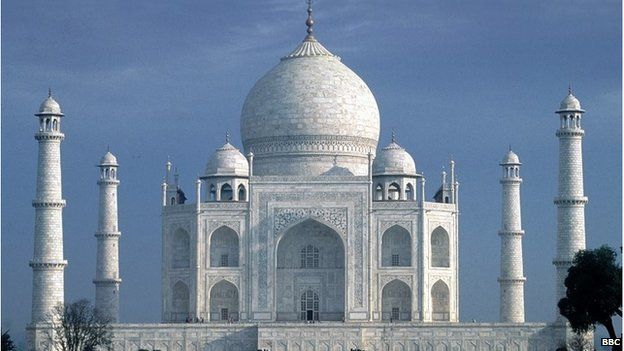Tamil Taj Mahal is a 1999 Tamil film directed by Bharathiraja. The film featured the director's son, Manoj, alongside fellow debutant Riya Sen in the lead roles, with an ensemble supporting cast including Revathi, Radhika and Ranjitha.
Navigation Bar
Taj Mahal
Taj Mahal way built by the Mughal emperor Shah Jahan (1628-1658), who was the grandson of Akbar the great. As the history of Taj Mahal goes, it was built in the memory of his beloved queen Arjumand Bano Begum, better known as 'Mumtaz Mahal'.
Mumtaz Mahal was one of the most loved queens of emperor Shah Jahan. She was a niece of empress Nur Jahan and granddaughter of Mirza Ghias Beg I'timad-ud-Daula, who was the wazir of emperor Jehangir. Mumtaj Mahal was born in 1593 and died in 1631 at the age of 38. She lost her life in the city of Burhanpur during the birth of her fourteenth child. Shah Jahan was in deep sorrow at the death of the queen and decided to build the Taj Mahal, a marble wonder, in her rememberence. Soon after her death her mortal remains were buried in the garden of Zainabad. Six months after her death, her body was transferred to Agra, and was finally enshrined in the crypt of the main tomb of the Taj Mahal. After the death of Shah Jahan, his last remains were also enshirned in the Taj Mahal. Therefore, the Taj Mahal is the mausoleum of both Mumtaz Mahal and Shah Jahan. The history of Taj Mahal is an ensemble of love and affection, due to which many regard it as the monument of love.
History Taj Mahal In Hindi

Taj Mahal, the great mausoleum, is located on the right bank of the river Yamuna. It is situated at a point, where the river takes a sharp turn and flows towards the east. The land where the Taj Mahal presently stands originally belonged to the Kachhwahas of Ajmer (Rajasthan). It is testified by Abdul Hamid Lahauri, a court historian, in his book titled 'Badshah-Namah and the Firmans (Royal Decrees)' that the land for the Taj Mahal was acquired by the Kachhwahas in lieu of four havelis.
For construction of the Taj Mahal, An area of around three acres was excavated. It was filled with dirt to reduce seepage, and levelled at 50 metres (160 ft) above riverbank. In the tomb area, wells were dug and filled with stone and rubble to form the footings of the tomb.Masons, stonecutters, inlayers, carvers, painters, calligraphers, dome-builders and other artisans were requisitioned from the whole of the empire and otherplaces in the world, like Central Asia and Iran. While bricks for internal constructions were locally prepared, white marble for external use in veneering work was obtained from Makrana in Rajasthan. Semi-precious stones for inlay ornamentation of the Taj Mahal were brought from far of regions in India, Ceylon and Afghanistan. Red sandstone of different tints was requisitioned from the neighbouring quarries of Sikri, Dholpur, etc. It took 17 years for the Taj Mahal to be ready, and the monument was completed in 1648.
Over all, the Taj Mahal covers a large area of 60 bighas (nearly 40 acres). The terrain gradually slopes from south to north, towards the river, in the form of descending terraces. At the southernmost point of the Taj Mahal is the forecourt with the main gate in front. It has tombs of two other queen of Shah Jahan, namely Akbarabadi Begum and Fatehpuri Begum, on the south-east and south-west corners, which are known as Saheli Burj 1 and 2.

Karate kid watch online. On the second terrace, in the complex is a spacious square garden with side pavilions. The garden is divided into four quarters by broad shallow canals of water, with wide walkways and cypress avenues on the sides. The water channels and fountains are fed by overhead water tanks. These four quarters are further divided into the smaller quarters by broad causeways, so that the whole scheme is in a perfect char-bagh (four-gardens).
The main tomb of the Taj Mahal is a square with chamfered corners. The minarets of the monument are detached, facing the chamfered angles (corners) of the main tomb on the main plinth. Red sandstone mosque on the western side, and Mehman-Khana on the eastern side of the tomb provides an aesthetically appealing colour contrast.
The Taj Mahal has some wonderful specimens of polychrome inlay art both in the exterior and interior on the dados, on the cenotaphs and on the marble jhajjhari (jali-screen) around them.
Download a Trial of Home Designer Pro or Architectural. Home designer pro software.